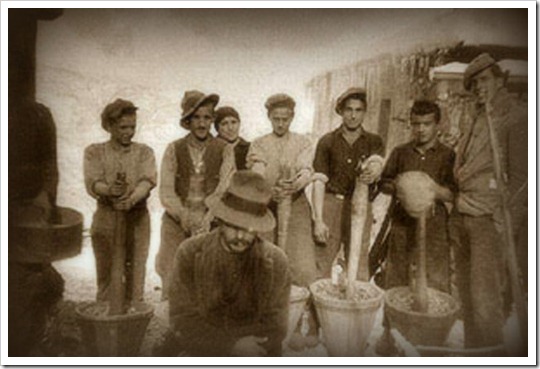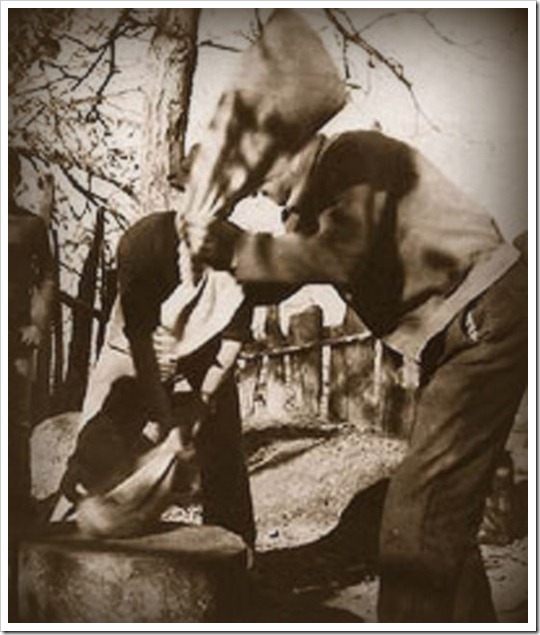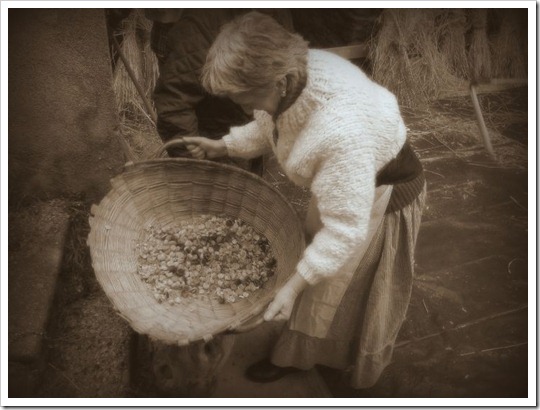The Tree of Life – Part 2 Posted by Geoff on Jan 28, 2015 in Culture
essiccare = to dry/desiccate
sbucciatura = to de-husk/peel
metato/seccatoio = chestnut drying barn
farina di castagne = chestnut flour
gràfié e bigungia = dialect name for a large pestle and mortar
malàta = hemp sack used for removing the husk from chestnuts
vasùra = tray for winnowing the chestnuts, from vassoio = tray
In part 1 of this series we discovered how le castagne, historically one of the main sources of nutrition for many Italian peasant farmers, were essiccate in the metato, or seccatoio. This delicate and time consuming process was only the first stage in the transformation of the fresh fruit into la farina di castagne. Today we’re going to look at stage 2, la sbucciatura. Once again, I’ve taken excerpts from an in depth article that I recently discovered in the online news sheet TuttoMontagna and translated them into English for you.
 |
| … armati di gràfié e bigungia … Photo public domain. |
Appena terminata la fase di essiccazione, finché le castagne erano ancora calde, si doveva subito separare il frutto dalla buccia. Per questo motivo, nei pressi del metato, si radunavano molti uomini che, armati di gràfié e bigungia, iniziavano questa operazione per la quale è necessario dare qualche spiegazione.
As soon as the drying process was finished, and whilst the chestnuts were still hot, the fruit had to be immediately separated from the husk. To carry this out, lots of men gathered together near the metato and, armed with gràfié e bigungia, began the operation. This needs a bit of explanation.
Da sopra i canìcce le castagne venivano messe direttamente dentro la bigungia (recipiente in legno a forma tronco-conica dell’altezza di 50 cm. circa) dentro alla quale veniva fatto roteare il gràfié, un bastone di un metro e mezzo d’altezza con un diametro di circa 10 centimetri che verso la base si allargava, per poi tornare al diametro iniziale nella parte terminale, sormontata da una corona dentata in ferro.
From on top of the lathes (see part 1) the chestnuts were put directly into la bigungia (a wooden container about 50 cm high shaped like a truncated cone) inside which the gràfié was rotated. The gràfié was a stick 1.5 meters long and about 10 cm in diameter which widened towards the base, before returning to its original diameter at the end, where it was fitted with a toothed iron ‘crown’.
 |
| Using la malàta to de-husk the chstnuts. Photo public domain |
Con il preciso movimento che gli esperti raccoglitori riuscivano a dare al gràfié, le castagne all’interno della bigungia si sbucciavano senza rompersi. In epoca precedente, questa operazione si effettuava mettendo le castagne calde nella malàta, un sacco di canapa abbastanza lungo la cui estremità diventava il manico per battere le castagne int e pilôn, un solido ceppo di legno solitamente a tre piedi. Per evitare che i sacchi si strappassero, venivano unti con una poltiglia di farina, acqua e grasso.
With the precise movement that the expert (chestnut) gatherers were able to give the pestle, the chestnuts in the mortar were de-husked without being broken. In the preceding era, this operation was carried out by putting the warm chestnuts in the malàta, a quite long hemp sack whose end became the hand grip for beating the chestnuts ‘int e pilôn’ (against the pilôn in dialect), a solid block of wood which usually had three feet. To prevent the sacks from tearing they were oiled with a mixture of flour, water and grease.
 |
| … questa volta erano le donne a dimostrare grande maestria … |
Il contenuto della malàta, come quello della bigungia, veniva poi vuotato nella vasùra (una specie di grosso vassoio di legno con tre bordi rialzati) dove questa volta erano le donne a dimostrare grande maestria facendo “saltare” con gesto ritmico le castagne che si separavano in aria dalla pula (poi raccolta e conservata per l’anno dopo) e ricadevano, pulite, nella vasùra, pronte a proseguire il loro cammino verso il mulino. Ma questa è un’altra storia…
The contents of the malàta, like those of the mortar, were emptied into la vasùra (a type of large wooden tray with three raised edges), and it was now the women’s turn to demonstrate their mastery by making the chestnuts “jump” with a rhythmic gesture so that they separated in the air from their husks (which were then collected and saved for the following year, see part 1), and fell back, clean, into the vasùra , ready to continue their journey towards the mill. But that’s another story …
to be continued …

Build vocabulary, practice pronunciation, and more with Transparent Language Online. Available anytime, anywhere, on any device.




Leave a comment: